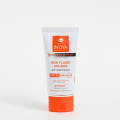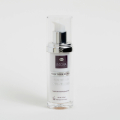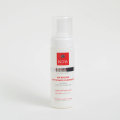Dark and Mixed Skin: Why Spots Appear After Sun Exposure (Pigmentary Rebound)
A Frequent but Misunderstood Phenomenon
On dark and mixed skin, it is very common to observe dark spots appearing several days or even weeks after mild sun exposure or minor inflammation. This phenomenon, known as pigmentary rebound or delayed hyperpigmentation, is a specific skin reaction for darker skin tones. Contrary to what one might think, these marks do not appear immediately. They occur “after the fact,” often when the skin seems to have healed. It is essential to understand why melanin-rich skin reacts more intensely and for longer in order to effectively prevent dark spots, post-acne marks, and solar hyperpigmentation.
Understanding Pigmentary Rebound
Pigmentary rebound corresponds in dermatology to what is called delayed post-inflammatory hyperpigmentation (late PIH). When the skin experiences irritation, even minor — a pimple, insect bite, micro-sunburn, or slight friction — the melanocytes, the cells responsible for producing melanin, can remain active several days after the apparent disappearance of the triggering event. Even imperceptible inflammation triggers a local inflammatory process that stimulates pigment production. The skin then produces melanin for an extended period, which explains why a pigment spot appears well after the incident.
In summary: for a moment, your skin seems normal, but its internal defenses keep working in the shadows. Result: a dark spot emerges, often darker than the surrounding skin tone, even without visible inflammation. This phenomenon affects both acne-prone dark skin and mixed or medium skin tones, as these post-acne or post-sun marks are feared and sometimes difficult to fade.
Why Does Dark Skin Mark for Longer?
The biological characteristics of dark, medium, and mixed skin explain why pigmentary rebound is particularly prevalent. First, melanin concentration is higher: melanocytes are more numerous, more active, and produce melanin more easily. Second, these pigment cells respond more persistently to inflammatory signals. Even mild inflammation, almost invisible on lighter skin, can trigger intense pigment production in the following days on dark skin.
Moreover, inflammation on dark skin can be silent: there is not always visible redness or swelling, but just an internal reaction. This time gap between skin aggression, the inflammatory peak, and spot appearance explains why we speak of delayed spots on medium skin or hyperpigmentation on dark skin after sun or acne.
The result is surprising: where light skin would show redness or peeling, dark skin marks more deeply, leaving dark and stubborn pigment scars. The appearance of dark/brown spots is therefore not only more frequent but also more persistent, which explains the importance of adopting targeted prevention at the slightest inflammation or exposure.
Aggravating Triggers of Pigmentary Rebound
Pigmentary rebound, although triggered by minor inflammation, is sometimes amplified by certain factors. Sun exposure, even brief and without visible sunburn, is enough to activate melanocytes. Dark skin tans less visibly, but stores more pigment internally, which appears a few days later. UVA and UVB rays activate existing melanin and can stimulate melanocytes to produce more pigment, even if no sunburn is apparent to the naked eye.
An acne flare-up, even discreet, can turn into a pigment mark if the skin is exposed to the sun or if the pimple is manipulated. Touching, scratching, or popping a pimple causes micro-inflammation that dark skin often translates into a persistent brown spot. Similarly, fabrics rubbing against the skin — like masks, tight clothing, or hair in prolonged contact — can induce repeated small irritations. Although barely visible, these micro-traumas are enough to trigger pigment production.
Additionally, urban or household pollution — including fine particles, oxidants, or heavy metals — generates oxidative stress and free radicals. This type of skin stress reinforces latent inflammation and activates melanocytes. Dark skin exposed daily to pollution therefore becomes more prone to hyperpigmentation, particularly under the sun or in the presence of moderate acne or rosacea.
Long-Term Consequences and the Importance of Consistency
Without consistent care, these pigment spots can last several months or even years. This affects skin tone uniformity, can impact self-confidence, and may lead to the overuse of harsh or overly strong depigmenting products. Over time, this uncontrolled reaction cycle can weaken the skin, disrupt the skin microbiome, and increase sensitivity to oxidative stress.
This is why professional dermatological or cosmetic support tailored to dark, medium, and mixed skin often recommends combining unifying actives, antioxidants, sun protection, and nutritional supplements. It is important to avoid overly aggressive treatments, frequent exfoliation, or strong depigmenting agents. A cumulative and progressive approach allows effective results without risk.
Effective Prevention for Dark, Medium and Mixed Skin
Preventing pigmentary rebound on dark skin requires a global strategy based on three complementary pillars.
1. Daily Sun Protection
Even in low sunlight or cloudy weather, applying a broad-spectrum SPF 50 sunscreen is essential. For dark skin, a fluid texture without a white cast is preferable, to avoid a greasy or streaky feeling. This sun protection should be reapplied every two hours outdoors, especially after physical activity, prolonged exposure, or swimming.
2. A Soothing, Purifying and Balancing Routine
Skin cleansing must be gentle, without harsh surfactants. Formulas enriched with salicylic acid and Zinc PCA are ideal to purify the skin and prevent pimples, while regulating excess sebum. Plant extracts with sebo-regulating properties help tighten pores and refine skin texture, while soothing actives help reduce irritation. This combination calms inflammation, limits imperfections, and promotes a more even skin tone.
3. "In & Out" Protection
This includes combining topical actives and dietary supplements. Formulas rich in vitamin C, zinc, grape polyphenols, vitamin E, and other antioxidants can help strengthen the skin barrier and reduce free radicals, thus slowing hyperpigmentation. These supplements are particularly useful before planned sun exposure or in cases of increased skin sensitivity to inflammation.
Additionally, using gentle exfoliating masks or treatments, such as enzymatic or mild mechanical peels, allows controlled exfoliation to promote cell renewal without visible irritation. This step must be carefully managed because an overly harsh exfoliant can cause more spots than it removes.
Science Insight
Post-inflammatory hyperpigmentation involves excess pigmentation caused by increased melanocyte stimulation due to inflammatory cytokines like interleukin-1 (IL-1) or tumor necrosis factor-alpha (TNF-α). These molecules are secreted in response to even microscopic inflammation. Melanocytes respond by synthesizing more melanin, sometimes overproduced for several days. In darker skin, melanocytes are more numerous and more “sensitive” to these inflammatory signals. A histological study showed that melanin is more densely stored in the keratinocytes of the basal and spinous layers of the epidermis, making spots more visible and persistent.
The secret to limiting post-inflammatory or post-solar hyperpigmentation lies in a consistent routine: sun protection, anti-inflammatory care, antioxidants, gentle exfoliation, and nutritional supplements. The approach must remain gentle, progressive, respectful of the skin barrier, and paired with constant preventive measures.
Protect Your Skin from Pigment Rebound with the IN'OYA Routine
Effectively protect your skin after sun exposure and prevent the appearance of new dark spots with the IN & OUT IN’OYA routine. This routine combines external protection and internal action to strengthen your skin’s natural defense against UV rays and pigmentation disorders.
Act from the inside and outside to maintain an even, radiant complexion, even after sun exposure.








